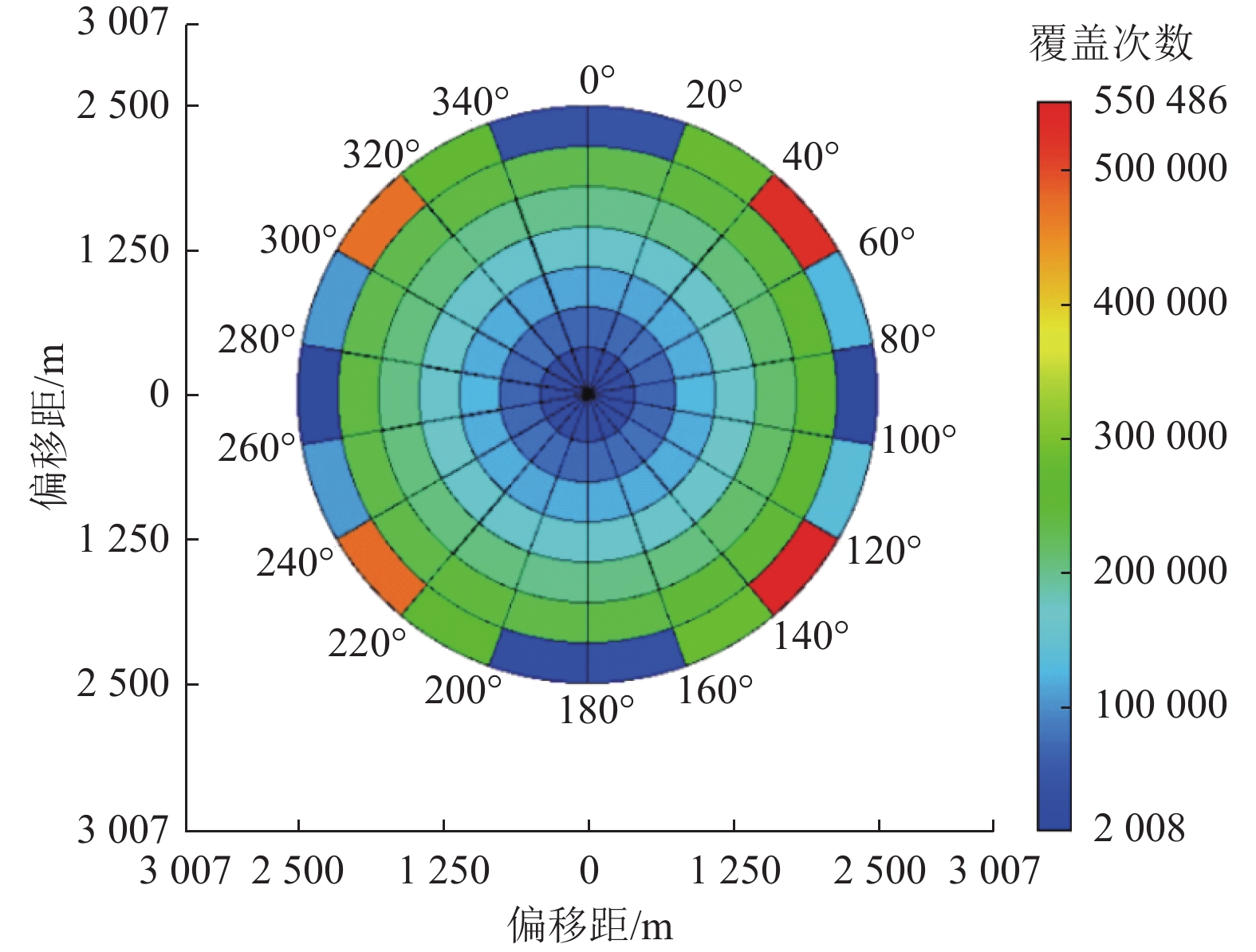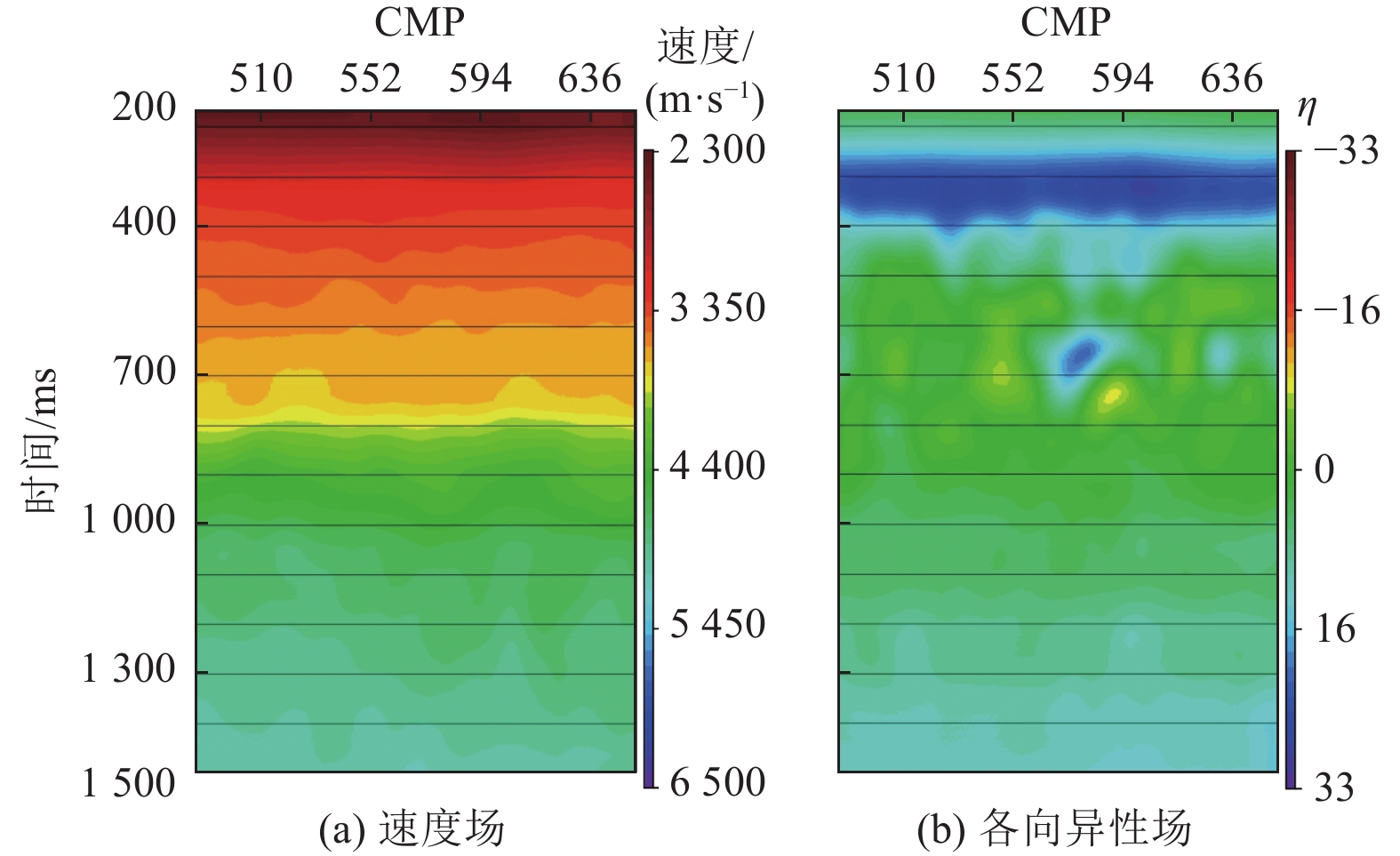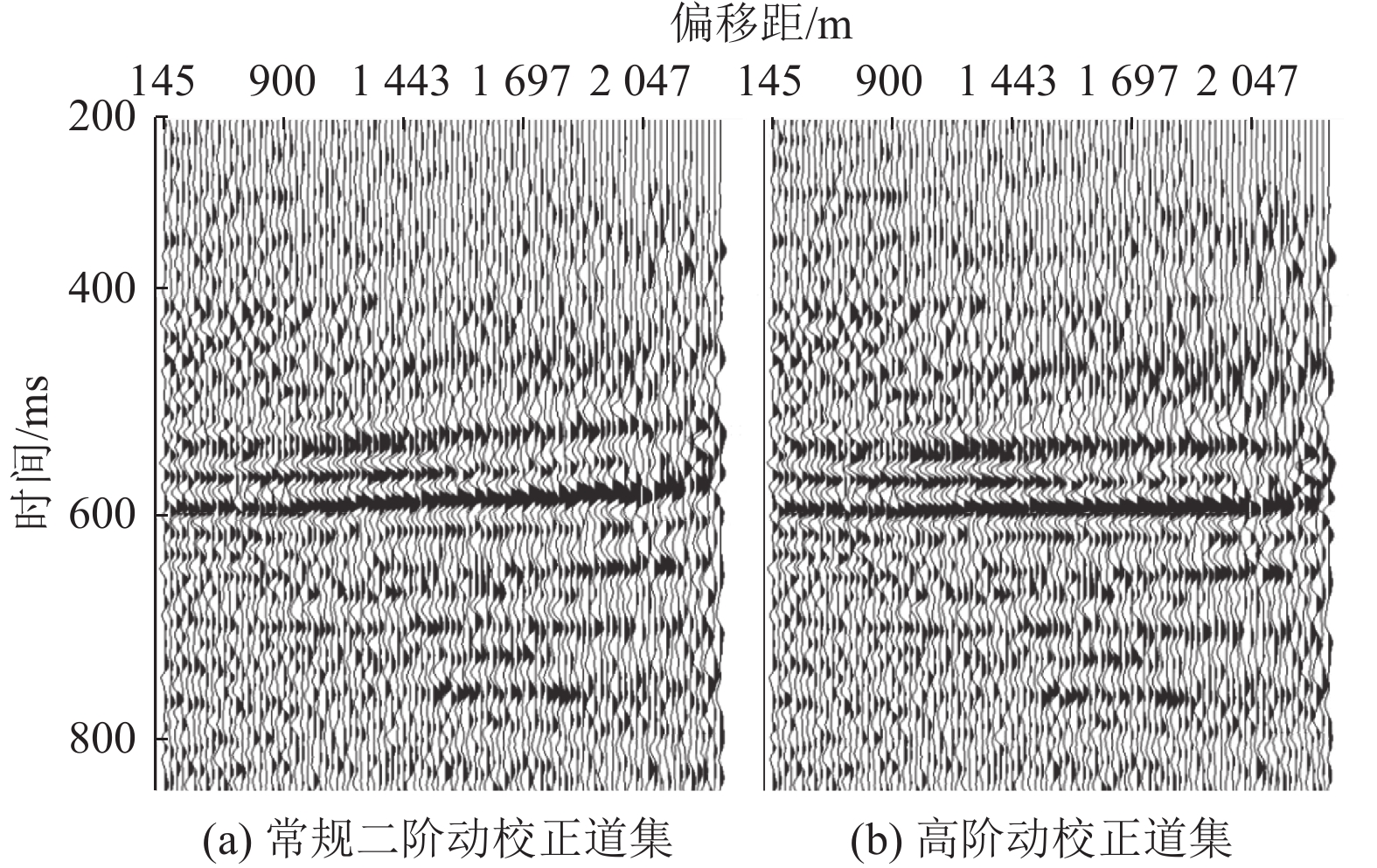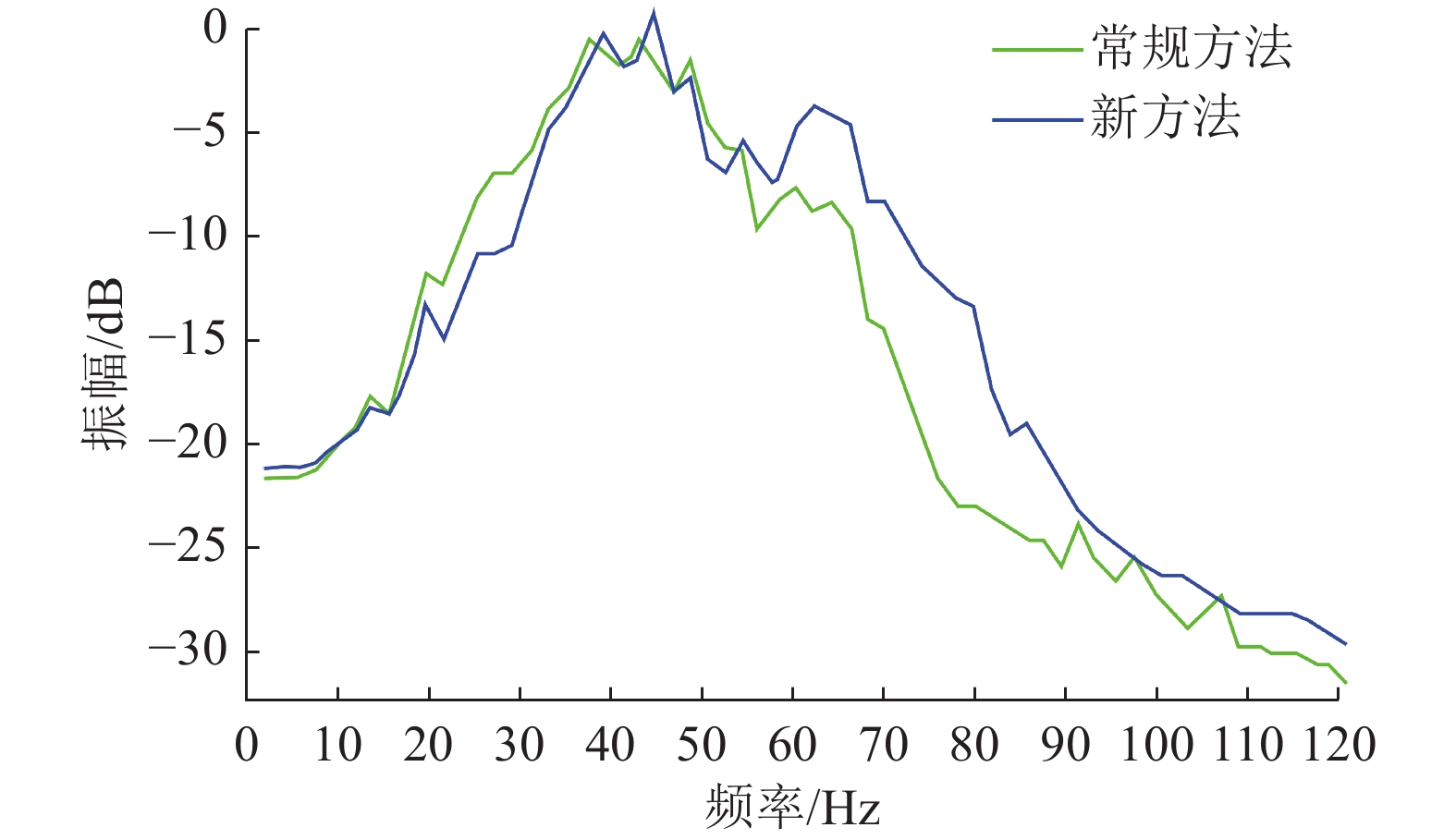A high-resolution method for processing coal measures seismic data based on anisotropic medium theories and its application
-
摘要:
【目的】随着深部资源勘探开发的重要性不断提高,对高精度地震勘探提出了新要求。针对具有强各向异性的含煤地层,传统基于各向同性的资料处理方法不再适用。【方法】提出一种基于水平横向各向同性介质(Transverse Isotropy Medium with Vertical Symmetry Axis,VTI)和方位各向异性介质(Transverse Isotropy with Horizontal Axis of Symmetry,HTI)联合处理的地震数据处理方法。首先,针对含煤地层沉积特征,分析VTI介质特点,采用高阶动校正处理,可以有效消除各向异性在大偏移距数据中引起的同相轴弯曲,保证共反射点远近道能达到同相,提高数据叠加成像质量。其次,针对构造裂隙发育特征,立足于HTI介质的方位各向异性分析,采用OVT域处理方法,通过建立方位各向异性参数场去除不同方位角差异对数据的影响。联合应用上述2种处理方法,通过制定合理的处理流程,优选关键参数,搭建一套实用的、适合目标地层的各向异性处理校正方法,解决含煤地层在复杂条件下的速度分析、叠加等问题,从而提高煤系地震数据的分辨率和解释精度。【结果和结论】实际应用结果表明,新方法获得的地震数据主频更高、频带更宽,在小构造特征识别和古地理环境刻画方面更具优势,为精细地质解释提供了有力支撑。同时也强调了对含煤地层进行各向异性处理的必要性,推动各向异性处理技术的在宽方位地震勘探中的应用。
Abstract:[Objective] The increasing importance of the exploration and exploitation of deep resources poses new requirements for high-precision seismic exploration. Given that conventional isotropy-based data processing methods are no longer applicable to the coal-bearing strata with strong anisotropy. [Methods] This study proposed a method for processing seismic data based on theories of both transverse isotropy medium with a vertical symmetry axis (VTI) media and transverse isotropy with a horizontal axis of symmetry (HTI) media. First, to characterize the depositional characteristics of coal-bearing strata, this study analyzed the features of VTI media, revealing that high-order dynamic correction can effectively eliminate anisotropy-induced event bending in large-offset seismic data, thus ensuring that the common reflection points in both far and near channels can be in-phase and improving the data stacking and imaging quality. Second, targeting the characteristics of tectonic fissures, this study relied on the azimuthal anisotropy analysis of HTI media. Specifically, using Offset-Vector Tiles (OVT) domain processing, the influence of varying azimuthal differences on data was removed by establishing the parameter fields of azimuthal anisotropy. Using both methods, this study developed a practical processing and correction method suitable for target strata with anisotropy by establishing a rational process and choosing optimal key parameters. This method can achieve effective velocity analysis and data stacking of coal-bearing strata under complex conditions, thus improving the resolution and interpretation accuracy of coal measures seismic data. [Results and Conclusions] The application results indicate that the new method can obtain seismic data with higher dominant frequency and a wider frequency band and is more advantageous in identifying the features of small structures and characterizing paleogeographic environments, thereby providing strong support for the fine-scale geological interpretation. This study highlighted the necessity of the processing of anisotropy for coal-bearing strata, potentially promoting the applications of anisotropy processing techniques in wide-azimuth seismic explorations.
-
煤层气作为一种重要的清洁能源,其开发利用对我国能源供给具有重要意义[1-2]。但含煤地层地质条件复杂,且资源勘探逐步向深部和复杂区发展,地质各向异性影响日益突显,给地震勘探的处理和解释工作带来诸多挑战。
随着宽方位地震勘探技术的在煤田的广泛应用,为充分利用大偏移距及方位角信息,提高其在复杂地质条件下的应用效果,本研究从含煤地层出发,分析地层地质条件的地球物理特征,开展各向异性处理在地震资料处理过程中的研究[3-4]。含煤地层为具有明显层理结构的沉积岩,可简化为具有垂直对称轴的横向各向同性(Transverse Isotropy Medium with Vertical Symmetry Axis,VTI),即VTI介质,同时由于多期构造活动,在含煤地层中常形成垂直或近垂直于地层的裂隙,故而煤层又可简化为具有水平对称轴的垂向各向同性(Transverse Isotropy with Horizontal Axis of Symmetry,HTI)介质,即HTI介质[5-6]。传统基于各向同性的资料处理在应用中受到极大的限制,其成像难以准确反映地层的真实信息[7],不再适用于具有强各向异性特征的含煤地层。
地震勘探中各向异性主要表现为地震波在地下传播过程中遇到的不同介质对其传播速度和方向的影响。通过对各向异性介质中地震波传播响应特征分析可知,地震波在VTI介质中传播时距曲线为非双曲线,区别于各向同性介质中的双曲线[8-9]。HTI介质中裂缝方位各向异性影响地震波传播速度,不同方位角地震波速度差异显著,表现为随方位变化的椭圆。这些不同于各向同性介质的地震波响应特征导致常规处理方法误差增大,表明各向异性处理在宽方位大偏移距地震资料中的必要性。因此,利用VTI和HTI介质理论对煤系地震数据进行高分辨处理成为目前的研究热点。
然而,现有方法通常基于各向同性处理或仅考虑VTI、HTI介质其中一方面的处理[10-12],难以全面消除含煤地层中2种类型各向异性的综合影响。如VTI介质处理注重消除纵向各向异性,而HTI介质处理专注于校正方位各向异性,但分析含煤地层特性,2种各向异性往往共存。单一的VTI或HTI介质处理手段,无法彻底解决复杂含煤地层中各向异性的影响,难以进一步提高地震数据的分辨率和成像精度[13]。
基于此,笔者从含煤地层出发,提出一种融合VTI介质高阶动校正和HTI介质OVT域处理的新方法,通过制定合理的处理流程、优选关键参数,以提高分辨率、准确成像为目标,为精细解释提供良好数据基础。
1 方法原理
1.1 VTI介质特性
含煤地层作为韵律性薄互层可简化为具有垂向对称轴的横向各向同性介质(VTI介质)[14]。
对于各向同性介质,水平反射面旅行时方程为:
$$ {{t^2} = t_0^2 + \frac{{{x^2}}}{{v_{{\mathrm{NMO}}}^2}}} $$ (1) 常规处理中,计算旅行时公式一般只适用于小偏移距范围,主要考虑小偏移距对目的层旅行时的影响。但当炮检距远大于目的反射层深度时,远偏移距部分由于纵向分布导致的各向异性引起旅行时误差对高精度处理有重要影响,不能被忽略。因此,针对VTI介质,通过引入各向异性参数η,使得动校正中远偏移距数据可以得到有效校平。水平反射面的纵波旅行时具体公式如下:
$$ {{t^2} = t_0^2 + \frac{{{x^2}}}{{v_{{\mathrm{NMO}}}^2}} - \frac{{2\eta {x^4}}}{{v_{{\mathrm{NMO}}}^2\left[ {t_0^2v_{{\mathrm{NMO}}}^2 + \left( {1 + 2\eta } \right){x^2}} \right]}}} $$ (2) 上式较各向同性介质的水平反射面旅行时方程多出高阶4次项,表明各向异性介质中,反射面旅行时不再遵循双曲线轨迹。即在VTI介质中的时间域处理,不仅包括纵波水平反射层小排列叠加速度,也包括反映各向异性程度的参数η。其中,η只在四次时差项中出现,且在η=0时可简化为各向同性下的双曲线方程,表明各向异性参数在大炮检距上才有意义。
1.2 HTI介质特性
含煤地层发育近垂向的裂缝,可简化为具有水平对称轴的各向同性介质。在HTI介质中,地震反射波的振幅、传播速度及频率等参数在平面上呈现椭圆特征[15-17]。
HTI介质速度场由3个参数定义:快速速度场(fast velocity,椭圆长轴)、慢速速度场(slow velocity,椭圆短轴)和慢速速度与inline方向的夹角β(图1)。
基于此,某一炮检方向φ的速度可以表示为:
$$ {\frac{1}{{v_\varphi ^2}} = \frac{{{{\mathrm{cos}}^2}\alpha }}{{v_{{\text{slow}}}^2}} + \frac{{{{\mathrm{sin}}^2}\alpha }}{{v_{{\text{fast}}}^{\text{2}}}}} $$ (3) 联系实际地层,椭圆长轴方向指示裂缝走向,沿裂缝走向速度大;椭圆短轴方向与裂缝走向垂直,传播速度较慢。
在一个CMP道集中,不同炮检距与不同方位角接收的反射波旅行时曲线可表示为:
$$ t_x^2 = t_0^2 + \left( {\frac{{{{\cos }^2}\alpha }}{{v_{{\text{slow}}}^{\text{2}}}} + \frac{{{{\sin }^2}\alpha }}{{v_{{\text{fast}}}^{\text{2}}}} - \frac{1}{{v_{{\text{ref}}}^2}}} \right){x^2} $$ (4) 方位各向异性剩余时差指被趋势拉平同相轴上似余弦曲线的扰动时差。即应用最佳成像速度进行多方位叠前时间偏移后,道集同相轴应被校平,若未校平,则为方位各向异性引起的剩余时差。当成像速度偏差较大时,校正后的同相轴不但会有随炮检距变化的低频时差,还有方位各向异性引起的高频时差。当参考速度偏大,则校正后的同相轴有下拉趋势;反之,参考速度偏小,则校正后同相轴有上翘趋势。因此,引入“允许的最大成像参考速度误差”参数进行速度调整,控制校正后的同相轴的下拉与上翘程度,从而实现方位各向异性校正[18-22]。
2 各向异性条件下的煤系地震资料处理
2.1 研究区概况
研究区位于山西省沁水盆地,区内石炭−二叠系含煤地层沉积稳定,地球物理性质差异明显,具有显著的VTI介质特性。此外,在多期构造应力作用下,区内断裂构造发育,具有HTI介质特性。研究区主要含煤地层为二叠系的山西组和石炭−二叠系的太原组,共含煤12层。其中3号、15号煤层全区稳定,是开采主力煤层,山西组2号煤层局部可采。3号煤层位于山西组下部,煤厚1.6~6.3 m,含夹矸1~3层,夹矸岩性为泥岩或炭质泥岩,属稳定性煤层。15号煤层位于太原组下段顶部,上距3号煤层约100 m,煤厚2.8~6.6 m,含夹矸1~3层,夹矸岩性为炭质泥岩,同属稳定性煤层。2号煤层位于山西组下部,煤厚0~1.6 m,研究区内东部煤层缺失,西部发育薄煤层,属于不稳定煤层。
本次地震资料采集采用宽方位观测系统(图2),横纵比为1。由玫瑰花图(图3)可见,在偏移距范围2500 m以内,基本为全方位。在常规基于各向同性处理的基础上,根据研究区实际地质情况,采用“基于VTI介质的高阶动校正处理、基于HTI介质理论OVT域处理”的新方法解决地震波传播时的各向异性特征。
2.2 OVT域基础处理
针对地层各向异性处理前需要对数据进行基础处理,包括道集分选、插值与偏移。
道集分选即对数据进行OVT单元划分,根据炮线距和检波线距等距离划分矩形。理想情况下,一个满覆盖CMP道集分组后每一个组里基本满足一次覆盖。但受变观测系统影响,区内会出现覆盖大于1次或者未覆盖的情况,通过采用五维插值规则化处理可以减少覆盖不均匀,衰减采集脚印、偏移划弧等噪声,提高成像质量及偏移道集结果。
OVT域叠前时间偏移采用克希霍夫偏移法,输入五维插值后OVT道集,此偏移方法较常规偏移保留偏移距和方位信息,有利于后续方位各向异性校正、叠前反演、构造和岩性识别等[23-25]。OVT偏移后的OVG(Offset Vector Gather)道集较共反射点道集道数更多,整体能量更均衡,近、中、远道能量趋于一致。
2.3 VTI型介质的高阶动校正
高阶动校正适用于VTI介质在大炮检距中剩余静校正完成后道集数据上的剩余速度,目的是消除或减少剩余速度误差,即消除动校误差对数据的影响,保证共反射点远近道能达到同相,从而提高叠加成像质量[26]。
由于纵波大排列反射波走时依赖于小排列动校速度和各向异性参数。因此,基础动校速度可以在小排列资料中利用速度谱扫描的方式获得。对大偏移距数据所带来的速度各向异性问题,则采用高密度自动双谱分析实现各向异性动校正。其基本原理是基于介质的非椭圆位移双曲线方程,利用高密度的速度参数和各向异性参数进行动校正。通过拾取并输出t0和Δtn两个参数场。经过空间插值与转化计算后,得到动校正速度和各向异性参数η场(图4)。最后由高密度非双曲线动校完成对道集的高阶动校正,解决剩余速度对叠加成像带来的影响。
高阶动校正方法主要是在提供了高密度、高精度速度及各向异性场的条件下对全部共中心点道集进行“空间逐点、时间逐层位”非双曲线高阶动校正处理,在偏移距任意大时(到90°入射角)均可校平。
基于所得速度场和各向异性场完成高阶动校正处理,由校正效果对比分析(图5)可以看出,约600 ms处同相轴在远偏移距处校正效果对比明显。如图5a所示,常规动校正后道集远偏移距处同相轴向上弯曲,即存在剩余时差;图5b则表明,高阶动校正后道集远偏移距处同相轴得以拉平。由此可知,在长排列采集情况下,高阶动校保留了更多的远道信息,校正后剖面上同相轴连续性变好,能有效提高成像质量,更有利于后续解释。
2.4 HTI型介质的方位时差校正
为判断实际资料是否存在方位各向异性,需对剖面与道集特征进行分析。图6分方位振幅叠加结果显示不同方位偏移成像特征有一定的差异,表明地层存在方位各向异性。图中目的层反射波成像形态差异主要在小断层处,方位角60°~90°上同相轴有一定的错断。同时部分区域存在振幅强弱变化,异常特征较明显。
地震波在各向异性介质中传播时,不同方位传播速度不一致,在速度图表示为随方位变化的椭圆,在OVG道集中直观表示为同相轴抖动(图7)。如果抖动很大,数据沿炮检距方向改变极性,会降低叠加效果,甚至会使某些弱同相轴消失。因此,为实现高分辨成像,应消除各个方向的走时或速度差异再进行叠加。方位各向异性校正原理是对每一道的实际数据与模型道进行匹配,计算出每一道的时差,从而得到整个研究区的位移场,在空间上进行平滑后,将所得位移场应用到数据中,最终实现空间相关的局部同相轴拉平。
校正首先拾取得到时变剩余时差和相关系数,根据时变剩余时差与校正的时差数据、相关系数数据和OVT叠前时间偏移速度场(成像参考速度),来估算方位各向异性参数,包括:快速速度、慢速速度和慢速方位(图8)。其中快速速度与慢速速度的比值反映了地层各向异性程度。这些各向异性信息不仅可用于后续叠加,也可用于裂缝、地应力和含气性等的反演。
将存在各向异性剩余时差的地震道反射波旅行时校正为零炮检距处反射波旅行时,即完成方位各向异性时差校正。经过各向异性校正后道集上同相轴抖动现象基本消除[27]、连续性增强、一致性更好(图9)。同时处理保留了方位角信息,后续可得到分方位道集,进行裂缝预测。
3 结果与讨论
对比新方法与常规处理叠加剖面结果发现,二者基本特征一致,但层间的细节信息更丰富,各反射层波组特征更清楚(图10),有效提高了地层刻画分辨率。对比频谱分析结果(图11),可以看出新方法较常规处理方法得到的数据体主频增加,获得数据体的频带得到有效拓宽,尤其是高频部分对数据分辨率具有重要影响。分频扫描(图12)进一步证明了最终处理结果数据体目的层段的频带范围较宽,为5~100 Hz,在地震资料解释中,频带宽度越大,能够使用的地震成果资料的频率(波数)成分越多,识别的地质目标就越精细,地震资料的分辨率越高。
断层、挠曲及裂隙存在会引起煤层反射波的方位各向异性[28-30],基于HTI介质理论,地震波沿断裂及裂隙系统方向传播时,速度快、衰减慢、高频成分丰富、分辨率高,垂直时相反。因此,基于处理生成的高分辨数据,根据已知的区域构造发育规律,从五维数据抽取沿断层走向为主方位的优势方位地震数据体,结合属性解释技术,可以提高断层、陷落柱等构造的识别能力与精度。对比新方法与常规方法处理后的优势方位数据体与全方位数据体(图13),可以发现断层及小构造变化在属性平面上特征比常规处理得到的数据表现更加明显、清晰。
同时,通过分析2组不同属性可以发现,新方法有效提高了小微构造识别精度和沉积特征刻画。比较2种方法从部分区域的相干属性和瞬时振幅属性切片(图14)可知,与常规处理获得的数据相比,新方法获得的数据更准确,达到了精细解释的目的。图14a相干属性切片中1、2处指示的煤层陷落柱经过高分辨处理后形态更精确,3处则消除了常规处理数据中的陷落柱假象。根据研究区地质条件,2号煤沉积环境为三角洲平原,部分受河流侵蚀影响。图14b所示虚线为古河道位置,在新处理方法切片数据中,对古河道边界的描述更清晰,对河道方向的预测更具说服力。
4 结 论
(1) 针对含煤地层具有的沉积特性,基于VTI介质特点,采用高阶动校正处理能有效消除大偏移距数据中的各向异性影响,校平远、近偏移距数据,提高叠加成像质量。
(2) 针对含煤地层常发育高角度裂缝特点,分析HTI介质的方位各向异性,基于OVT域处理方法,校正剩余时差,表现为同相轴抖动被校平,达到去除方位角信息对数据影响的目的。
(3) 将VTI介质高阶动校正和HTI介质OVT域处理两种方法联合应用,制定合理流程,优选关键参数,可以全面消除各向异性因素对数据的影响,显著提高煤系地震数据的分辨率和解释精度,为精细地质解释提供有力支撑。
(4) 对比方法应用前后处理结果的频率,可以发现新方法获得的地震数据主频更高、频带更宽。属性分析则表明新方法在小构造特征识别和古地理环境刻画方面更具优势。
符号注释:
t0为零偏移距双程旅行时,s;tx为炮检距为x时的反射波旅行时,s;
$\Delta {{t}_{n}} $ 为最大偏移距动校正量,s;vfast为快速速度,m/s;vNMO为水平反射面的时差速度,m/s;vref为输入数据的成像参考速度,m/s;vslow为慢速速度,m/s;x为炮点到检波点偏移距,m;α为地震数据某一炮检方向与慢速速度方向的夹角,(°);β为慢速速度与Inline方向的夹角,(°);η为有效的各向异性参数;φ为地震数据某一炮检方向与Inline方向的夹角,(°)。利益冲突声明/Conflict of Interests
所有作者声明不存在利益冲突。
All authors disclose no relevant conflict of interests.
-
-
[1] 姚艳斌,王辉,杨延辉,等. 煤层气储层可改造性评价:以郑庄区块为例[J]. 煤田地质与勘探,2021,49(1):119−129. DOI: 10.3969/j.issn.1001-1986.2021.01.012 YAO Yanbin,WANG Hui,YANG Yanhui,et al. Evaluation of the hydro–fracturing potential for coalbed methane reservoir:A case study of Zhengzhuang CBM field[J]. Coal Geology & Exploration,2021,49(1):119−129. DOI: 10.3969/j.issn.1001-1986.2021.01.012
[2] 邢廷栋,薛诗桂,黎小伟,等. 黄土塬区延安组煤层地震响应特征物理模拟研究[J]. 煤田地质与勘探,2021,49(6):87−94. DOI: 10.3969/j.issn.1001-1986.2021.06.013 XING Tingdong,XUE Shigui,LI Xiaowei,et al. Physical modeling of seismic response for the coal seams of Yan’an Formation in loess tableland of North China[J]. Coal Geology & Exploration,2021,49(6):87−94. DOI: 10.3969/j.issn.1001-1986.2021.06.013
[3] 王赟,郑永芹,杨春,等. 煤层长波长地震各向异性的多尺度效应初探[J]. 煤田地质与勘探,2023,51(2):263−272. DOI: 10.12363/issn.1001-1986.22.12.0921 WANG Yun,ZHENG Yongqin,YANG Chun,et al. A preliminary study on the multiscale effect of seismic anisotropy of coal seams at long wavelengths[J]. Coal Geology & Exploration,2023,51(2):263−272. DOI: 10.12363/issn.1001-1986.22.12.0921
[4] 钱进,崔若飞,陈同俊. 含煤地层各向异性介质有限差分数值模拟[J]. 煤田地质与勘探,2010,38(2):63−67. DOI: 10.3969/j.issn.1001-1986.2010.02.016 QIAN Jin,CUI Ruofei,CHEN Tongjun. Anisotropic numerical simulation of coal–bearing strata with finite–difference[J]. Coal Geology & Exploration,2010,38(2):63−67. DOI: 10.3969/j.issn.1001-1986.2010.02.016
[5] 李勤,王玮,马随波,等. HTI煤层方位AVO响应与裂隙识别[J]. 地球物理学进展,2021,36(1):178−186. DOI: 10.6038/pg2021DD0358 LI Qin,WANG Wei,MA Suibo,et al. Analysis of azimuthal AVO response and crack identification on HTI tectonic coal[J]. Progress in Geophysics,2021,36(1):178−186. DOI: 10.6038/pg2021DD0358
[6] 姬广忠,吴荣新,张平松,等. 黏弹TI煤层介质3层模型Love槽波频散与衰减特征[J]. 煤炭学报,2021,46(2):566−577. JI Guangzhong,WU Rongxin,ZHANG Pingsong,et al. Dispersion and attenuation characteristics of Love channel waves in the three–layer model of viscoelastic TI coal seam media[J]. Journal of China Coal Society,2021,46(2):566−577.
[7] 邓志文,汪关妹,赵小辉,等. 宽方位HTI介质裂缝预测方法研究与应用[C]//中国石油学会. 2015年物探技术研讨会论文集. 宜昌,2015:516–518. [8] 李佳欣,杨春,王赟. 薄互层等效各向异性的研究现状与存在问题[J]. 石油物探,2021,60(2):224−237. DOI: 10.3969/j.issn.1000-1441.2021.02.004 LI Jiaxin,YANG Chun,WANG Yun. A state of the art on the equivalent anisotropy of thin interbeds[J]. Geophysical Prospecting for Petroleum,2021,60(2):224−237. DOI: 10.3969/j.issn.1000-1441.2021.02.004
[9] 徐世刚,刘洋. 基于优化有限差分和混合吸收边界条件的三维VTI介质声波和弹性波数值模拟[J]. 地球物理学报,2018,61(7):2950−2968. DOI: 10.6038/cjg2018L0250 XU Shigang,LIU Yang. 3D acoustic and elastic VTI modeling with optimal finite–difference schemes and hybrid absorbing boundary conditions[J]. Chinese Journal of Geophysics,2018,61(7):2950−2968. DOI: 10.6038/cjg2018L0250
[10] 姜鸿莺,陈刚,程晨. 各向异性速度分析技术在VTI介质地震资料处理中的应用:以南川地区为例[C]//中国地质学会2015学术年会论文摘要汇编(下册). 西安,2015:803–811. [11] 李慧婷,常锁亮,张生等. 基于各向异性高分辨地震处理的煤层顶板含水性风险评价[J/OL].[2023-07-31] 煤炭科学技术. https://kns.cnki.net/kcms2/article/abstract?v=8dkf_uZKVx1-aPUBDjLzbZuvVbFxvY2hmQEj7GebptFinYbZ4bkzWdFrd0WBNj1WZ9EYvK1gWYAAnH6jJSnZrqHQ0VbUAKg3nkTrwDN9idfNpN3gb0YJq7gUrXAV3fHnl46jTS6j9Bk=&;uniplatform=NZKPT&language=CHS. LI Huiting, CHANG Suoliang, ZHANG Sheng, et al. Evaluation of coal seam roof water–bearing risk area via anisotropic high–resolution seismic processing[J/OL]. [2023-07-31] Coal Science and Technology. https://kns.cnki.net/kcms2/article/abstract?v=8dkf_uZKVx1-aPUBDjLzbZuvVbFxvY2hmQEj7GebptFinYbZ4bkzWdFrd0WBNj1WZ9EYvK1gWYAAnH6jJSnZrqHQ0VbUAKg3nkTrwDN9idfNpN3gb0YJq7gUrXAV3fHnl46jTS6j9Bk=&;uniplatform=NZKPT&language=CHS.
[12] 付强,罗彩明. 基于VTI介质理论的P波速度分析和动校正[J]. 物探化探计算技术,2008,30(1):10−16. DOI: 10.3969/j.issn.1001-1749.2008.01.003 FU Qiang,LUO Caiming. P–wave nonhyperbolic moveout analysis in vti media[J]. Computing Techniques for Geophysical and Geochemical Exploration,2008,30(1):10−16. DOI: 10.3969/j.issn.1001-1749.2008.01.003
[13] 姜鸿莺. 复杂地表各向异性地震资料关键处理技术应用研究[D]. 东营:中国石油大学(华东),2015. JIANG Hongying. Research on key processing techniques of complex surface anisotropic seismic data[D]. Dongying:China University of Petroleum (Huadong),2015.
[14] RÜGER A. Variation of P–wave reflectivity with offset and azimuth in anisotropic media[J]. Geophysics,1998,63(3):935−947. DOI: 10.1190/1.1444405
[15] RÜGER A. P–wave reflection coefficients for transversely isotropic models with vertical and horizontal axis of symmetry[J]. Geophysics,1997,62(3):713−722. DOI: 10.1190/1.1444181
[16] 吴海波. 煤层气储层开采条件的地震评价方法研究[D]. 徐州:中国矿业大学,2016. WU Haibo. Seismic evaluation method research on exploitation condition of coal–bed methane reservoir[D]. Xuzhou:China University of Mining and Technology,2016.
[17] 田建章,陈会敏,曹建华,等. 各向异性处理技术探索与实践[J]. 石油天然气学报,2010,32(3):255−257. TIAN Jianzhang,CHEN Huimin,CAO Jianhua,et al. Exploration and practice of anisotropic treating techniques[J]. Journal of Oil and Gas Technology,2010,32(3):255−257.
[18] 刘军迎,雍学善,张静,等. 基于叠前全方位角道集方位振幅梯度各向异性变化的HTI裂缝介质油气检测方法与技术[J]. 地球物理学报,2021,64(10):3807−3816. DOI: 10.6038/cjg2021O0481 LIU Junying,YONG Xueshan,ZHANG Jing,et al. Oil and gas detection method and technique of HTI fracture media based on the anisotropic variation of azimuth–amplitude gradient in prestack omni–directional incidence–angular gather[J]. Chinese Journal of Geophysics,2021,64(10):3807−3816. DOI: 10.6038/cjg2021O0481
[19] 吴萍,杨长春,王真理,等. HTI介质中的反射纵波方位属性[J]. 地球物理学进展,2009,24(3):944−950. DOI: 10.3969/j.issn.1004-2903.2009.03.016 WU Ping,YANG Changchun,WANG Zhenli,et al. Reflection P–wave azimuthal attribute in HTI medium[J]. Progress in Geophysics,2009,24(3):944−950. DOI: 10.3969/j.issn.1004-2903.2009.03.016
[20] 龚明平,张军华,王延光,等.分方位地震勘探研究现状及进展[J]. 石油地球物理勘探,2018,53(3):642–658. GONG Mingping,ZHANG Junhua,WANG Yanguang,et al. Current situtions and recent progress in different azimuths seismic exploration[J]. Oil Geophysical Prospecting,2018,53(3):642–658.
[21] CORDSEN A,GALBRAITH M. Narrow– versus wide–azimuth land 3D seismic surveys[J]. The Leading Edge,2002,21(8):764−770. DOI: 10.1190/1.1503181
[22] 李昂,张丽艳,杨建国,等.宽方位地震 OVT域方位各向异性校正技术[J]. 石油地球物理勘探,2021,56(1):62 –68. Analysis and processing technology of azimuth anisotropy in OVT domain of wide-azimuth seismic data[J]. Oil Geophysical Prospecting,2021,56(1):62 –68.
[23] 印兴耀,张洪学,宗兆云. OVT数据域五维地震资料解释技术研究现状与进展[J]. 石油物探,2018,57(2):155−178. DOI: 10.3969/j.issn.1000-1441.2018.02.001 YIN Xingyao,ZHANG Hongxue,ZONG Zhaoyun. Research status and progress of 5D seismic data interpretation in OVT domain[J]. Geophysical Prospecting for Petroleum,2018,57(2):155−178. DOI: 10.3969/j.issn.1000-1441.2018.02.001
[24] SHI Ying,YU Bo,ZHOU Hui,et al. FMG_INV,a fast multi–Gaussian inversion method integrating well–log and seismic data[J]. IEEE Transactions on Geoscience and Remote Sensing,2024,62:4503112.
[25] YU Bo,SHI Ying,ZHOU Hui,et al. Fast Bayesian linearized inversion with an efficient dimension reduction strategy[J]. IEEE Transactions on Geoscience and Remote Sensing,2024,62:4502910.
[26] 徐翠娥,郝晓红,王影. 高密度双谱分析法在各向异性介质速度分析中的初步应用[J]. 海洋石油,2008,28(1):1−5. DOI: 10.3969/j.issn.1008-2336.2008.01.001 XU Cui’e,HAO Xiaohong,WANG Ying. Application of high density bispectral analyzing method to velocity analysis in anisotropy media[J]. Offshore Oil,2008,28(1):1−5. DOI: 10.3969/j.issn.1008-2336.2008.01.001
[27] 张丽艳,李昂,杨建国,等. 全方位道集速度建模方法及应用[J]. 地球物理学报,2022,65(10):4063−4072. DOI: 10.6038/cjg2022P0494 ZHANG Liyan,LI Ang,YANG Jianguo,et al. Full–azimuth gather velocity modeling method and application[J]. Chinese Journal of Geophysics,2022,65(10):4063−4072. DOI: 10.6038/cjg2022P0494
[28] 张宪旭. 基于宽方位地震数据的煤层裂隙预测方法研究[J]. 能源与环保,2021,43(7):114−119. ZHANG Xianxu. Study on coal seam fracture prediction method based on wide azimuth seismic data[J]. China Energy and Environmental Protection,2021,43(7):114−119.
[29] 熊晓军,张鑫,张本健,等.裂缝融合分析的窄方位叠前裂缝预测技术.石油地球物理勘探,2021,56(5):1150–1156. XIONG Xiaojun,ZHANG Xin,ZHANG Benjian,et al. Fracture prediction technology on prestack narrow azimuth data with fracture fusion analysis[J]. Oil Geophysical Prospecting,2021,56(5):1150–1156.
[30] 常锁亮,张生,刘晶,等. 薄互层条件下围岩变化对煤层反射波的影响研究[J]. 煤田地质与勘探,2021,49(5):220−229. CHANG Suoliang,ZHANG Sheng,LIU Jing,et al. Influence of surrounding rock changes on the coal seam reflected wave under thin interbed condition[J]. Coal Geology & Exploration,2021,49(5):220−229.
-
期刊类型引用(0)
其他类型引用(1)









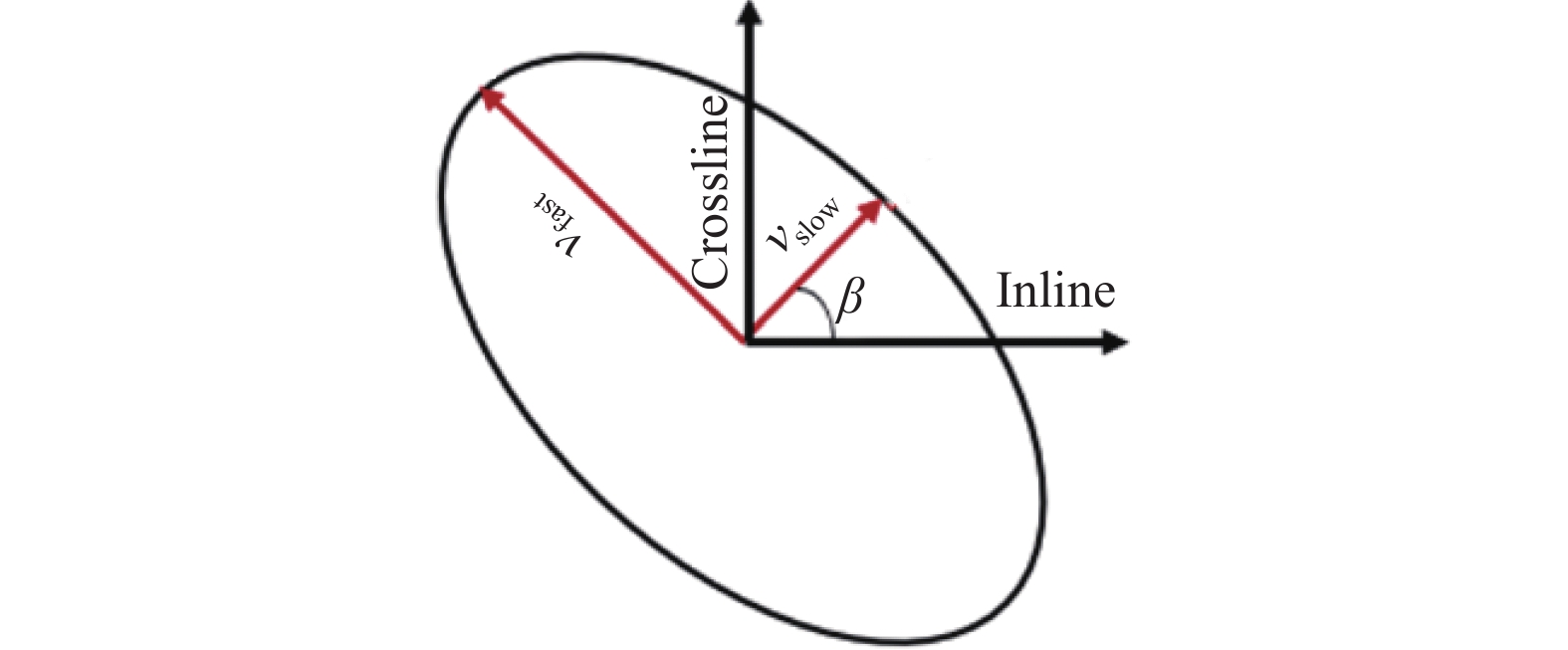
 下载:
下载:



